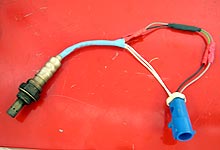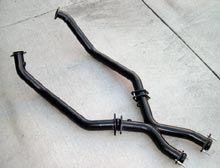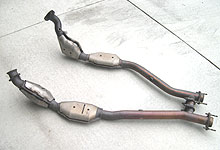|

It is rumored that Ford engineers
spent considerable time and money developing just the right
exhaust note for the 99-04 4.6L 2V Mustang. We give them props,
it is a pretty respectable rumble in stock form, but as with
most Mustangs, the stock exhaust tone does leave something to
be desired. The factory of course has to appease the masses,
most of whom do not want a alarm-triggering bark off idle and
"look-at-me" growl at wide
open throttle. Fortunately for those
of us that do appreciate the raucousness of un-stifled V8 there
is nothing like an off-road X pipe. We recently pulled our stock
four-cat pipe off our 2001 Mustang GT and installed in its place
a stealth looking black crossover pipe.
It's no news that there are dozens of companies and brands of
exhaust components for Mustangs. Some are high end and to their
credit use outstanding materials, while others are shoddy and
have poor fitting products. We picked up this X-pipe from Pacifica
Performance mainly because we were intrigued with it's black
coating and resonable $139 price tag. Also appealing to us was
the three piece design, making installation without a car lift
much easier then wrestling with a full length unit.
While improving the sound of your pony is reason enough to install
an off-road X pipe, the gain in power is also a nice side effect.
Even though Ford uses a 2.5" diameter exhaust system on
the '99 and up 4.6L Mustangs, the factory H-pipe utilizes two
pre-catalytic converters in front of the two full converters.
The result is a fairly restrictive system, especially once you
start putting mods on the breathing end of the motor. Granted
the stock exhaust manifolds are the true culprits in the anemic
exhaust system, their incredibly tight confinement between the
wide 4.6L and shock towers makes them a nightmare to swap out.
We'll tackle that in the future, for now we're content with
a simply cat-pipe swap out. We left the stock mufflers in place
so as not to get the awful drone associated with "cat back"
muffler systems. On the dyno the restriction free X-pipe showed
a 6-8 horsepower gain from 3000 to 5000 rpm, with a 2-3 HP loss
on the low end. Torque was up a max of 10 lb. ft. at 4400 rpm.
X- Pipe Installation
MIL Eliminators
We won't get into the legal disclaimers here regarding off-road
pipes, you know the laws in your state so do as you see fit.
We will mention however that removing the catalytic converters
will trigger a "check engine" light on 1996 and
up Mustangs. This is because the EEC-V engine management system
utilizes oxygen sensors both before and after the catalytic
converters. The computer expects to see voltage from the aft
O2 sensors corresponding to a lean mixture as a result of
exhaust gas cleaning by the converters. Removing the converters
sends the wrong signal, triggering a check engine light. Fortunately
there is a way to eliminate the problem. Several companies
sell "MIL Eliminators" (Malfunction Indicator Light).
The MIL eliminator is simply a resistor and capacitor circuit
placed in the O2 sensor harness that sends the computer the
lean signal (300mV) it expects to see. Below we've shown you
how to install the MIL Eliminators, or build your own, to
ensure check engine light free driving.

 The MIL Eliminators contain a circuit
which will simulate the expected lean condition at the
post cat O2 sensors. These are available from a number
of sources, or make
your own with Radio Shack parts.
The MIL Eliminators contain a circuit
which will simulate the expected lean condition at the
post cat O2 sensors. These are available from a number
of sources, or make
your own with Radio Shack parts.
|
|

 Cut the black and gray leads from
the O2 sensor. Splice in the MIL eliminator such that
the green lead connects to the cut black lead from the
02 connector. Match up the remaining gray and black ends.
Cut the black and gray leads from
the O2 sensor. Splice in the MIL eliminator such that
the green lead connects to the cut black lead from the
02 connector. Match up the remaining gray and black ends.

|
|
| |
|
|
| |
|
|
|
|
|
| |
|
In This Article:
We replace the stock, restrictive h-pipe on
our 2001 Mustang with a free-flowing X pipe.
|
|
|
| |
|
| |

The X-pipe from Pacifica Performance
is an intimidating component with it's black "HTS"
corrosion prevention coating. With over 3000 miles on our
pipe since installation the coating has shown no signs of
flaking or burning off. Pacifica also makes cat back systems
with similar coating. |
| |
|
| |

The factory H-pipe found on '99-'04
Mustangs is an improvement over previous years, being a
true 2.5" diameter pipe. However it is still restrictive
to power and sound with its four catalytic converters and
sharp bends.
|
| |
|
| |
|
| |
|
| |
Contact:
Pacifica
Mustang & Cobra
25060 Hancock Ave 103-158
Murrieta CA 92562
800-308-0082 |
|
|

